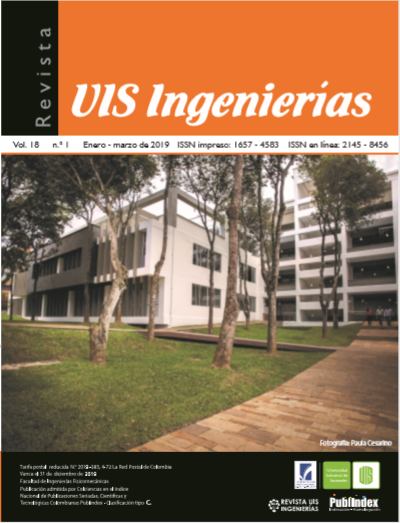Publicado 2019-01-02
Palabras clave
- CPVC,
- frecuencia de carga,
- método de los elementos de contorno,
- mecánica de la fractura,
- propagación de grietas por fatiga
- temperatura ...Más
Cómo citar
Resumen
En esta investigación se presenta un análisis del efecto combinado de la temperatura y la frecuencia de carga sobre la velocidad de crecimiento de la grieta por fatiga del cloruro de polivinilo clorado (CPVC). El CPVC es un material termoplástico utilizado para sistemas de tuberías en los que la temperatura y la resistencia química son importantes, características que lo convierten en una buena alternativa frente a los metales. El método dual de elementos de contorno (MDEC) se utiliza para determinar estados tridimensionales de esfuerzos y deformaciones en cada incremento de grieta. Los factores de intensidad de esfuerzos en la punta de la grieta se determinan usando la integral J. Un modelo matemático propuesto por Kim & Wang en 1994, basado en resultados experimentales, se aplica para predecir la velocidad de crecimiento. Para ello, se evalúa una muestra con una grieta lateral utilizando valores de temperatura entre 23 y 70 ºC y frecuencias entre 0,1 y 10 Hz. Los resultados muestran que la velocidad de crecimiento aumenta con el aumento de la temperatura y con la disminución de la frecuencia. Los resultados se comparan con el modelo de París y Erdogan y se revela una relación entre ellos, lo que implica que el MDEC podría ser una herramienta adecuada y precisa para investigar la predicción del crecimiento de la grieta en los polímeros.
Descargas
Referencias
H.-S. Kim y Y.-W. Mai, “Effect of temperature on fatigue crack growth in unplasticized polyvinyl chloride,” J. Mater. Sci., vol. 28, no. 20, pp. 5479 -5485, 1993. doi: 10.1007/BF00367818
M. Irfan-ul-Haq y N. Merah, “Effect of Temperature on Fatigue Crack Growth in CPVC,” J. Press. Vessel Technol., vol. 125, no. 1, pp. 71-77, 2003. doi: 10.1115/1.1523070
R. W. Hertzberg, J. A. Manson, y M. Skibo, “Frequency sensitivity of fatigue processes in polymeric solids,” Polym. Eng. Sci., vol. 15, no. 4, pp. 252–260, 1975. doi: 10.1002/pen.760150404
H. S. Kim y X. M. Wang, “Temperature and frequency effects on fatigue crack growth of uPVC,” J. Mater. Sci., vol. 29, no. 12, pp. 3209–3214, 1994. doi: 10.1007/BF00356664
Parson M, Stepanov EV, Hiltner A, Baer E., “Fatigue and Creep Crack Propagation Kinetics in PVC Pipe Material,” in The Annual Technical Conference (ANTEC) of the Society of Plastics Engineers, 2002, pp. 426-430.
F. Saghir, N. Merah, Z. Khan, y A. Bazoune, “Modeling the combined effects of temperature and frequency on fatigue crack growth of chlorinated polyvinyl chloride (CPVC),” J. Mater. Process. Technol., vol. 164–165, pp. 1550–1553, 2005. doi: 10.1016/j.jmatprotec.2005.02.206
M.H. Aliabadi, The Boundary Element Method, Applications in Solids and Structures Vol. 2. John Wiley & Sons, 2002.
J. Mackerle, “FEM and BEM in the context of information retrieval,” Comput. Struct., vol. 80, no. 20-21, pp. 1595-1604, 2002. doi: 10.1016/S0045-7949(02)00114-1
T. A. Cruse, “Numerical solutions in three dimensional elastostatics,” Int. J. Solids Struct., vol. 5, no. 12, pp. 1259–1274, 1969. doi: 10.1016/0020-7683(69)90071-7
T. A. Cruse, “Numerical Evaluation of Elastic Stress Intensity Factors by the Boundary Integral Equation Method, The Surface Crack: Physical Properties and Computational Solutions,” J.L. Swedlow (Ed.), ASME, New York, 1972, pp. 153-170
T. A. Cruse, “BIE fracture mechanics analysis: 25 years of developments,” Comput. Mech., vol. 18, no. 1, pp. 1–11, 1996. doi: 10.1007/BF00384172
A. Portela, M. H. Aliabadi, y D. P. Rooke, “The dual boundary element method: Effective implementation for crack problems,” Int. J. Numer. Methods Eng., vol. 33, no. 6, pp. 1269–1287, 1992. doi: 10.1002/nme.1620330611
Y. Mi y M. H. Aliabadi, “Dual boundary element method for three-dimensional fracture mechanics analysis,” Eng. Anal. Bound. Elem., vol. 10, no. 2, pp. 161–171, 1992. doi: 10.1016/0955-7997(92)90047-B
D. N. Dell’Erba, Thermoelastic fracture mechanics using boundary elements. WIT Press, 2002.
R. Balderrama, “Implementación de la Integral J de Dominio para el Análisis Tridimensional de Grietas en Problemas Termoelásticos utilizando el Método de Elementos de Contorno”, trabajo de fin de maestría, Universidad Central de Venezuela, Caracas, Venezuela, 2004.
W. H. Gerstle, “Finite and Boundary Element Modelling of Crack Propagation in Two and Three Dimensions using Interactive Computer Graphics”, tesis doctoral, Cornell University, New York, 1985.
P.C. Paris, F. Erdogan, “A Critical Analysis of Crack Propagation Laws,” J. Basic Eng., vol. 85, no. 4, pp. 528-533, 1963. doi: 10.1115/1.3656900
N. Merah, F. Saghir, Z. Khan, y A. Bazoune, “A study of frequency and temperature effects on fatigue crack growth resistance of CPVC,” Eng. Fract. Mech., vol. 72, no. 11, pp. 1691–1701, 2005. doi: 10.1016/j.engfracmech.2004.12.002

